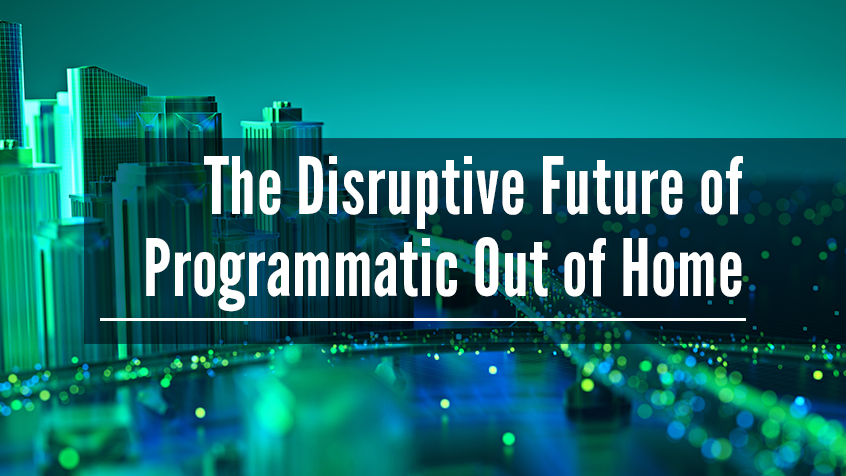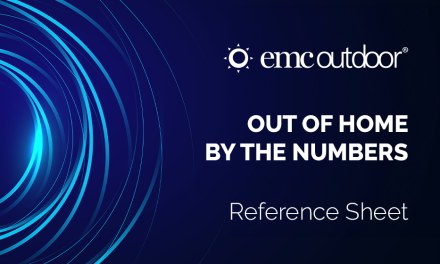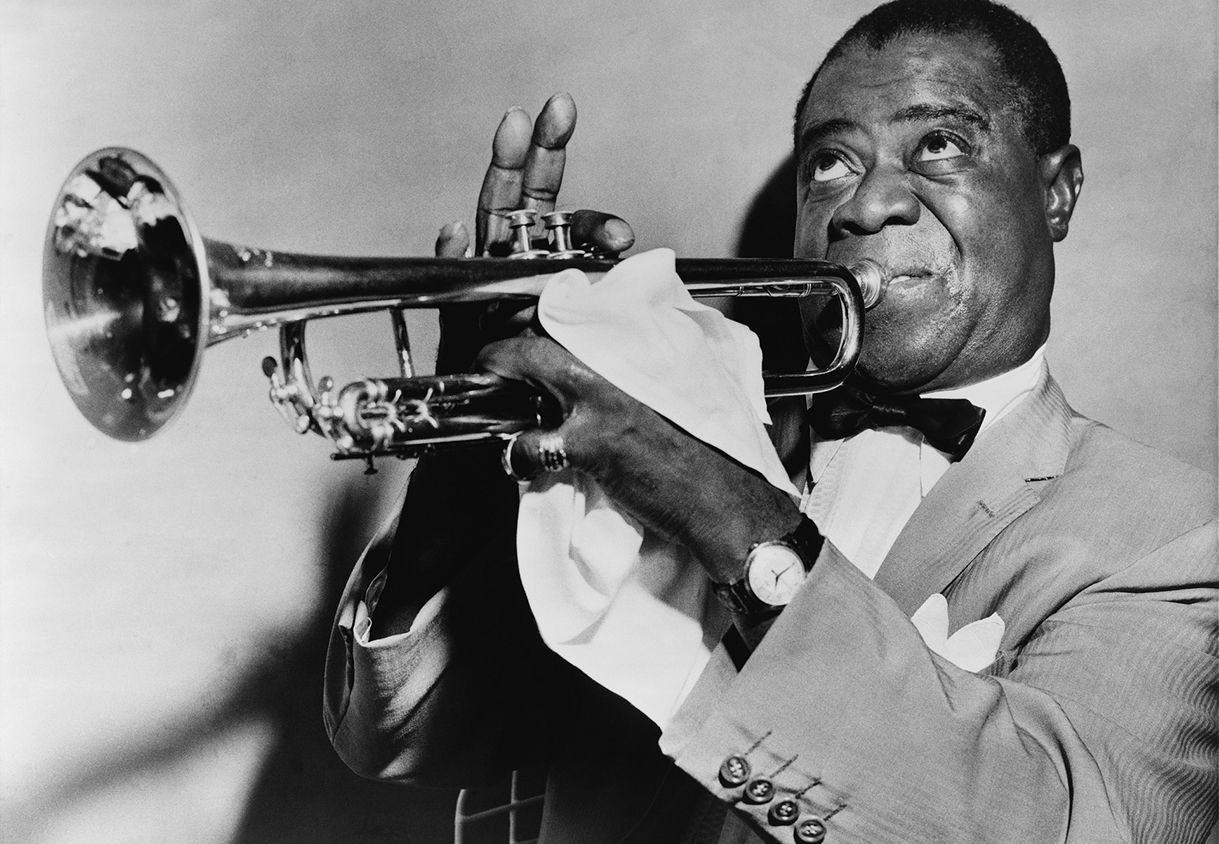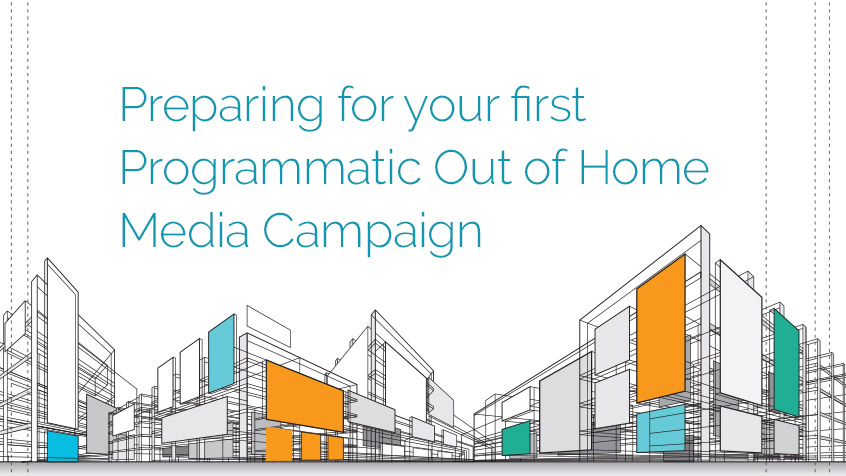I vividly remember facilitating a focus group of Out of Home industry peers four or five years ago, talking about the future of OOH, what changes were coming, and what that meant. When I posed the question, “What happens when we reach a critical mass of digital out of home media, and it can be bought programmatically through a trading desk?,” one member of the group snorted. The prospect was so ridiculous that they actually snorted in derision. Yeah, well, how’d that turn out?…
Disruption is a popular buzzword right now and is often thrown around in situations where it doesn’t really apply. This is not one of those situations. The changes that will take place in the Out of Home world as a result of programmatic will be nothing short of transformative. We are looking at a paradigm shift on par with the advent of computers.
Yet, while there is a lot of justified excitement around the topic, there is also a lot of misunderstanding. We want to help with some basic understanding on the topic on several fronts. But before we get into what programmatic DOOH is, it’s probably best to start with what it is not.
Programmatic DOOH is not the same as Online Programmatic
Most importantly, programmatic DOOH is not and will not be the same as online programmatic. It is a different media channel with its own unique landscape, strengths, weaknesses and other characteristics. To lump it in with online just because we can buy/sell it in a similar paradigm would be a grave mistake.
DOOH is still a one-to-many medium, not one-to-one like online. While the Out of Home industry is rapidly coming up with ways to make the media more interactive, it’s still not Ad = Click. And that’s ok. In today’s digital-first marketing ecosystem, we have become so focused on CTR’s, conversion rates and micro-conversions we have lost sight of the value of brand building and awareness.
The pricing of Programmatic DOOH will not mirror the pricing models for online programmatic – it won’t be a race to the bottom. The key driver for this is that DOOH media space has a limited supply. The physical nature of DOOH displays means there will always be a finite amount of media space. Compare that to the online advertising ecosystem which already has a virtually infinite amount of space available and is continuing to grow, and we see the difference. When the demand goes up and the supply is finite, the effect on pricing is unavoidable.
Add to that the fact that the impressions are more targeted (therefore, theoretically more valuable than before) and it might be a little more expensive. But, honestly, that’s ok, too. If the advertiser can buy a media plan that delivers impressions to their target audience more efficiently, they can buy a smaller overall plan, pay a little higher CPM, and still end up paying less for a better plan.
Programmatic DOOH is not ubiquitous…yet. If you follow the news, you’ll see a lot of talk about how programmatic is taking over. Remember, there is still a lot of static OOH media out there and it’s likely to be there for quite a while. Converting static units to digital is an expensive proposition, and while we are seeing rapid conversion in larger urban (read: more valuable media) areas, it will be a while before that reaches into smaller communities and more rural areas. The areas where we will mostly likely see rapid expansion of inventory are in place-based networks, like fitness clubs, retail environments, restaurants and malls. These networks offer less expensive installation and infrastructure and are more accessible. This plays well for programmatic buying as these place-based networks often reach unique audiences and behavioral/demographic profiles.

Where is Programmatic DOOH now?
Where we are now depends on who you ask. First off, let’s be clear when we talk about programmatic: it’s the automated buying and selling of media through digital platforms. The biggest factors contributing to this discussion are the growth of Digital Out of Home media space as a percentage of the overall available total, the development of infrastructure to seamlessly tie these spaces into SSP/DSP systems, and the huge growth in mobile data that allows for OOH targeting that far surpasses anything that was available in the past. Plus, the rapid development of video capabilities in DOOH helps to make the media more exciting and is reported to be 2.5 times more impactful.
What are the buying models for Programmatic DOOH?
Real Time Bidding (RTB) is essentially the same as online – media space is put up for auction in real time, in an open marketplace, and the highest bid (or second highest bid, depending on your model) will win the space.
Private Marketplace (PMP) deals will also function similarly to online – in this scenario advertisers are buying in a more limited, invitation only type of auction. Think of it as a smaller pool of buyers competing for the same inventory.
The third model, currently referred to as Programmatic Direct, is essentially an automated version of today’s model. Essentially, the media is booked in advance and a certain set of media, impression level or time frame is “guaranteed.”
We will most likely see all of these paradigms coexisting because the media is finite and vendors need to fill their inventory. A certain portion of the media will be purchased in advance, some will be placed into PMPs, while another portion of the available space will be reserved for RTB auctions. This will allow for a good deal of flexibility on both sides of the buy/sell equation and will work to everyone’s benefit.
What benefits can we see from Programmatic buying right now and in the very near future?
Efficiency, accuracy and flexibility. The automation of the planning/buying/selling process will make it simpler, faster and require less labor. This will allow agencies and advertisers to focus on the human element of campaigns, like strategy, creative and storytelling. It will also allow campaigns to scale more efficiently to larger markets or audiences and enable them to be planed and bought alongside traditional digital channels that integrate well with out of home, like mobile.
We can see a distinct advantage in the shift from media focused planning to audience focused planning. In the past, OOH was planned based on the “stick in the ground.” Now, thanks to huge strides in location data and planning by Geopath, we can start to shift our focus to the audience. How will the plan deliver the audience we are looking for? The actual media becomes less important and we can place more emphasis on the audience we are delivering. A key element of that shift is derived from the abundance of audience location data available from mobile devices, and how we can use that information to look at audiences’ movements through a market.
In addition to audience data, we can also start to layer in other data sources, like environmental, time, temperature, sports, news, stocks, etc. Since the buying is automated, it means these data sources can connect directly to the platform without the need for human intervention, and allow conditional triggers to guide the buying process.

The buying and selling of DOOH in automated platforms will also bring an unprecedented level of flexibility to the channel. We will be able to access a wider variety of choices more efficiently and balance the amount of each channel more easily, without the back-and-forth of proposals and negotiations. It will allow for creative to be deployed based on audience composition, timing, and the triggers mentioned above. The creative can be more easily tested, evaluated, and optimized over the duration of the campaigns to allow advertisers to make the most of their adspend. It will allow for scheduling flexibility down to just the hours you want to buy (i.e. just weekday morning rush, weekday evening rush, Thursday-Saturday promoting weekend events). The possibilities are almost limitless.
What are the challenges that need to be addressed?
The Out of Home industry has a unique opportunity to learn from the mistakes of those who came before. With digital advertising using programmatic techniques for a number of years, the OOH community can look at what worked and, more importantly, what didn’t. It can guide the development of this new paradigm and, hopefully, avoid the pitfalls that have plagued the online ecosystem.
The industry needs to establish clear standards and practices for the buying and selling of programmatic DOOH. This should apply to measurement, buying scenarios, expectations for delivery and proof of play. Transparency will be key across the board. These need to be agreed on by all the media operators, SSPs, DSPs, agencies, advertisers – everyone. An excellent first step was taken this year with the release of a best practices for Digital Out of Home, developed in cooperation by the Digital Place Based Advertising Association (DPAA), Digital Signage Federation (DSF), Interactive Advertising Bureau (IAB), Geopath and Out of Home Advertising Association of America (OAAA). Additionally, the appointment of Anna Bager as the new head of the OAAA is particularly timely as her leadership will bring invaluable insights to the process from her time at IAB.
It’s imperative that the Out of Home industry not fall into the traps that online programmatic did. Transparency of process and measurement will be a key part of this. It’s easy enough to avoid the problems of fraudulent bot traffic and brand safety.
The OOH community will need to engage in some rigorous education on all fronts. Professionals along the entire chain – from advertiser to agency to vendor – will need a crash course in what programmatic DOOH can and cannot do, the strengths and weakness, how to target and plan, and so on. A key piece of this education should focus on dispelling the myth that programmatic is cheap. The word has taken on a strong connotation of “lowest price” and the industry will need to be educated on why that is not the case. If we allow buyers to come to the marketplace with the expectation of bargain basement pricing, they will be frustrated and disappointed and will miss the true value proposition of a highly targeted, efficient OOH campaign.
We will also need education on when and why to use programmatic and how to use the new, ever-evolving targeting capabilities, especially in regard to creative. If we view programmatic DOOH in the same way we view the static posters of yesterday, we will be grossly under-using its true capabilities.
This could all give rise to a new kind of media planner/buyer in the OOH world. A position that is a hybrid of both traditional OOH and traditional digital media buying which draws on the skills from either side and enables planners to build campaigns that capitalize on the strengths of this new paradigm.
Finally, we should not give in to the temptation to try and measure DOOH in the same way we measure online. The Out of Home industry needs to develop its own measurement and methodology regarding attribution, measurement and ROI. Remember our first point? DOOH is not that same as digital online – it’s still a one-to-many medium.
The industry should work to develop attribution systems that allow OOH to showcase its own unique strengths. The media is a vibrant, powerful, flexible, adaptable media that is fully capable of standing on its own merits. We would be doing both the media and us a disservice to try and fit a square peg into a round hole, just for the sake of saying – “look, we’re just like digital.” The measurement and attribution part of the OOH landscape is one of the most exciting areas right now. Numerous systems and models are becoming available to track everything from digital clicks, to footfall, to brand awareness and sentiment, and to track them back to Out of Home campaigns. This should continue to be an area of focus across the industry –always with an eye to measuring what Out of Home does best.
A bright future for Out of Home.
One of my favorite authors, Tom Goodwin, talks a lot about disruption in various industries. He put it this way: “Sometimes, the end result of that funnel is the best solution based on those criteria, but there is a better way to solve the same problem, but only when someone explores a solution with very different design assumptions. I believe what we witness is the leap from a world of possibilities to another, a leap from one paradigm to another, an optimal solution based on a whole new world of thinking. This is a paradigm leap and it’s the essence of disruption.”
We’re on the verge of a new OOH paradigm in which the efficiency, flexibility, targeting and dynamic nature of Digital Out of Home will allow the medium to deliver audiences in ways that we’re only beginning to fully understand. The next few years will be an exciting time as infrastructure is developed and refined, as we enhance our own skills, and as emerging platforms and tech become more consolidated and integrated into our existing media planning systems.
Make no mistake, while we may not be all the way there yet we are right at the inflection point, this is the future path for Out of Home. It’s a path that will be filled with bumps for sure, but if we work together as an industry with a clear idea of where that path is leading, it will result in an media channel that is fundamentally transformed and ready to move from the margins, and take its place as a core media for any plan.
Contact Us to learn more.





